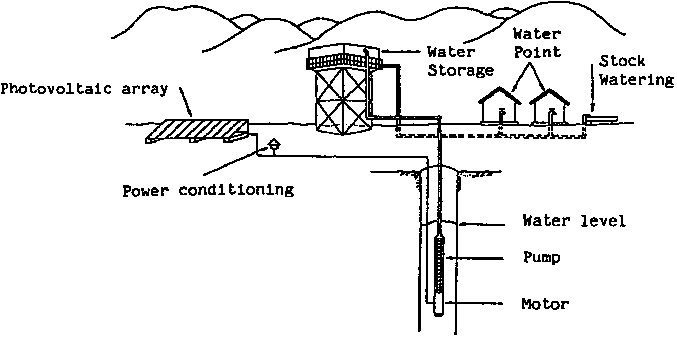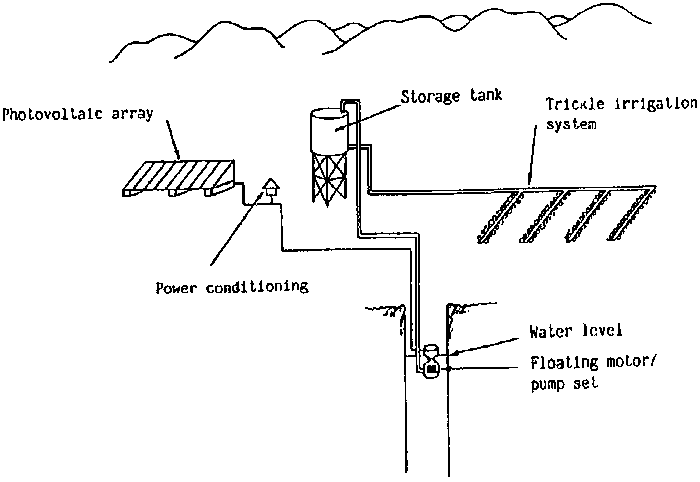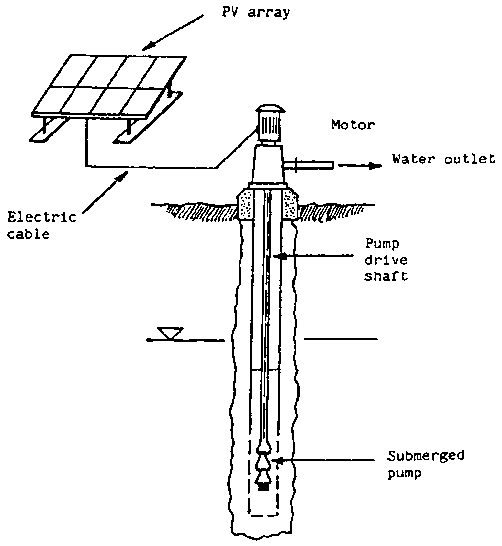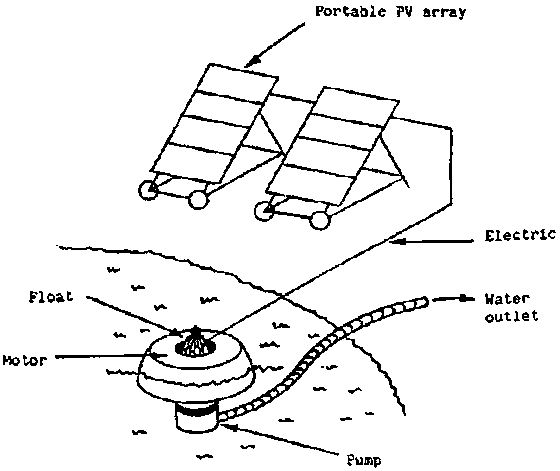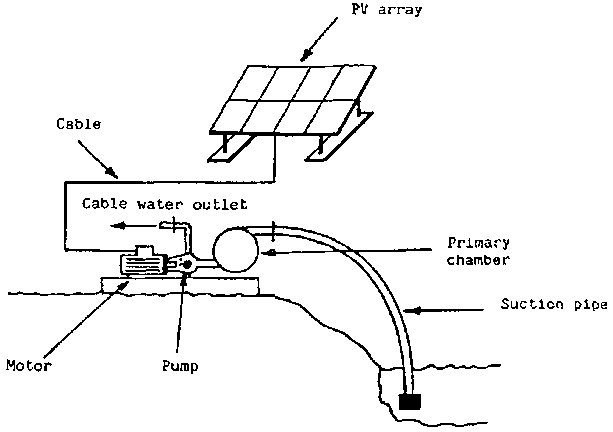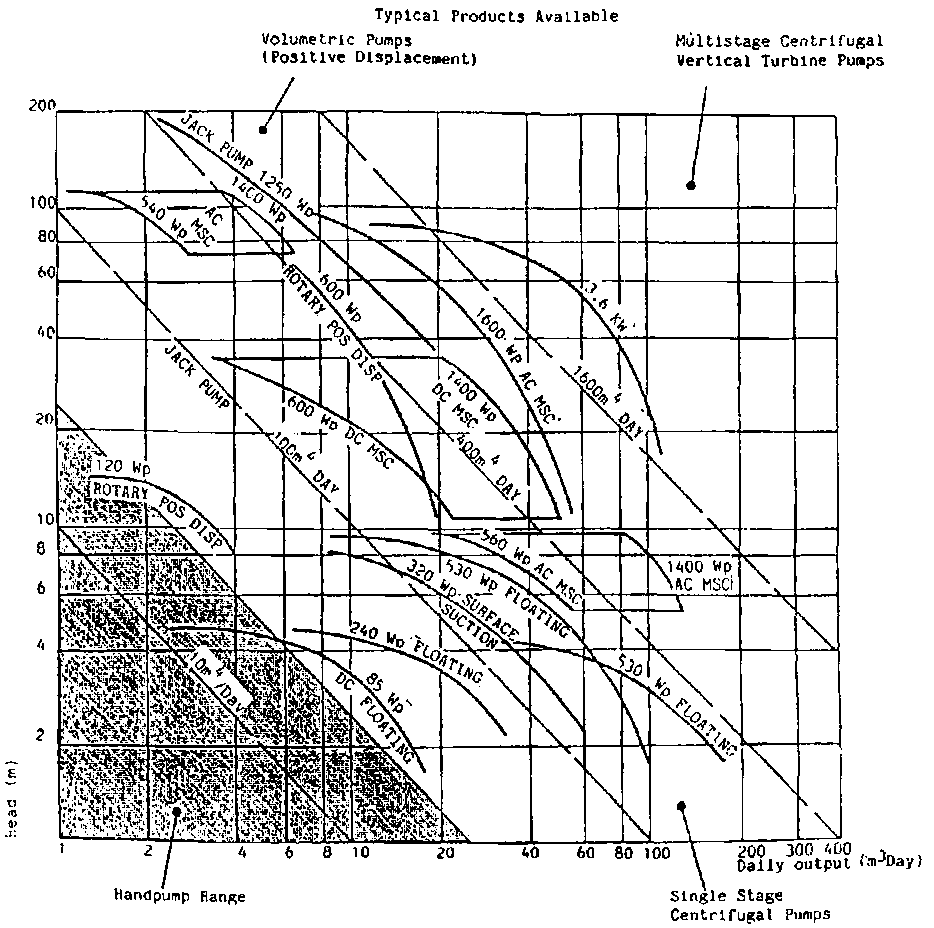How to Make a Solar Pump
Contents
Solar (Photovoltaic) Water Pumping - Technical Brief
Technology challenging poverty
Introduction
Water pumping has a long history; so many methods have been developed to pump water with a minimum of effort. These have utilised a variety of power sources, namely human energy, animal power, hydro power, wind, solar and fossil fuels for small generators. The relative merits of these are laid out in Table 1 below.
Table 1: Comparison of pumping techniques
|
Advantages |
Disadvantages | |
|
Hand pumps |
• local manufacture is possible |
• loss of human productivity |
|
Animal driven pumps |
• more powerful than humans |
• animals require feeding all year round |
|
Hydraulic pumps (e.g. rams) |
• unattended operation |
• require specific site conditions |
|
Wind pumps |
• unattended operation |
• water storage is required for low wind periods |
|
Solar PV |
• unattended operation |
• high capital costs |
|
Diesel and gasoline pumps |
• quick and easy to install |
• fuel supplies erratic and expensive |
Applications
Solar pumps are used principally for three applications:
• village water supply
• livestock watering
• irrigation
A solar pump for village water supply is shown schematically in Figure 1. With village water supply, a constant water demand throughout the year occurs, although there is need to store water for periods of low insolation (low solar radiation). Typically in Sahelian Africa the storage would be 3-5 days of water demand. In environments where rainy seasons occur, rainwater harvesting can offset the reduced output of the solar pump during this period. The majority of the 6000 or more solar pumping systems installed to date are for village water supply or livestock watering.
A solar irrigation system (Figure 2) needs to take account of the fact that demand for irrigation water will vary throughout the year. Peak demand during the irrigation seasons is often more than twice the average demand. This means that solar pumps for irrigation are under-utilised for most of the year. Attention should be paid to the system of water distribution and application to the crops. The system should minimise water losses, without imposing significant additional head on the pumping system and be of low cost.
The suitability of major irrigation systems for use with solar pumps is shown in Table 2.
Table 2: Suitability of major irrigation methods for use with solar pumps
|
Distribution method |
|
|
|
|
Open Channels |
|
|
|
|
Sprinkler |
|
|
|
|
Trickle/drip |
|
|
|
|
Flood |
|
|
|
The technology
Systems are broadly configured into 5 types as described below:
Submerged multistage centrifugal motor pumpset - Figure 3
This type is probably the most common type of solar pump used for village water supply. The advantages of this configuration are that it is easy to install, often with lay-flat flexible pipework and the motor pumpset is submerged away from potential damage.
Either ac or dc motors can be incorporated into the pumpset although an inverter would be needed for ac systems. If a brushed dc motor is used then the equipment will need to be pulled up from the well (approximately every 2 years) to replace brushes. Brushless dc motors would require electronic commutation. The most commonly employed system consists of an ac pump and inverter with a photovoltaic array of less than 1500Wp.
Submerged pump with surface mounted motor - Figure 4
This configuration was widely installed with turbine pumps in the Sahelian West Africa during the 1970s. It gives easy access to the motor for brush changing and other maintenance.
The low efficiency from power losses in the shaft bearings and the high cost of installation has been disadvantages. In general this configuration is largely being replaced by the submersible motor and pumpset.
Reciprocating positive displacement pump - Figure 5
The reciprocating positive displacement pump (often known as the jack or nodding donkey) is very suitable for high head, low flow applications.
The output is proportional to the speed of the pump. At high heads the frictional forces are low compared to the hydrostatic forces often making positive displacement pumps more efficient than centrifugal pumps for this situation.
Reciprocating positive displacement pumps create a cyclic load on the motor which, for efficient operation, needs to be balanced. Hence, the above ground components of the solar pump are often heavy and robust, and power controllers for impedance matching often used.
Floating motor pump sets - Figure 6
The versatility of the floating unit set, makes it ideal for irrigation pumping for canals and open wells. The pumpset is easily portable and there is a negligible chance of the pump running dry.
Most of these types use a single stage submersed centrifugal pump. The most common type utilises a brushless (electronically commutated) dc motor. Often the solar array support incorporates a handle or 'wheel barrow' type trolley to enable transportation.
Surface suction pumpsets - Figure 7
This type of pumpset is not recommended except where an operator will always be in attendance. Although the use of primary chambers and non-return valves can prevent loss of prime, in practice self-start and priming problems are experienced. It is impractical to have suction heads of more than 8 metres.
Performance
The performances of some commercially available products are shown in Figure 8. Solar pumps are available to pump from anywhere in the range of up to 200m head and with outputs of up to 250m³/day.
Solar pumping technology continues to improve. In the early 1980s the typical solar energy to hydraulic (pumped water) energy efficiency was around 2% with the photovoltaic array being 6-8% efficient and the motor pumpset typically 25% efficient. Today, an efficient solar pump has an average daily solar energy to hydraulic efficiency of more than 4%. Photovoltaic modules of the monocrystalline type now have efficiencies in excess of 12% and more efficient motor and pumpsets are available. A good sub-system (that is the motor, pump and any power conditioning) should have an average daily energy throughput efficiency of 30-40%.
Costs
A photovoltaic pumping system to pump 25m³/day through 20m head requires a solar array of approximately 800Wp in the Sahelian regions. Such a pump would cost approximately $6,000 FOB. Other example costs are shown in Table 3.
A range of prices is to be expected, since the total system comprises the cost of modules, pump, motor, pipework, wiring, control system, array support structure and packaging. Systems with larger array sizes generally have a lower cost/Wp. The cost of the motor pumpset varies according to application and duties; a low lift suction pump may cost less than $800 whereas a submersible borehole pumpset costs $1500 or more.
Table 3: Photovoltaic pumping system specifications
|
Motor pump/ |
Output (m³.day) @ 5kWhm/cu.m/ day insolation |
Head (m) |
Solar Array (Wp) |
System Price |
|
Submerged borehole motor pump |
40 |
20 |
1200 |
7000-8000 |
|
Surface motor/ |
60 |
7 |
840 |
5000-6000 |
|
Reciprocating positive displacement pump |
6 |
100 |
1200 |
7500-9000 |
|
Floating motor/pumpset |
100 |
33 |
530 |
4000 |
|
Surface suction pump |
40 |
4 |
350 |
3000 |
Procurement
Assessing requirements
The output of a solar pumping system is very dependent on good system design derived from accurate site and demand data. It is therefore essential that accurate assumptions are made regarding water demand/pattern of use and water availability including well yield and expected drawdown.
Domestic water use per capita tends to vary greatly depending on availability. The long-term aim is to provide people with water in sufficient quantities to meet all requirements for drinking, washing and sanitation. Present short-term goals aim for a per capita provision of 40 litres per day, thus a village of 500 people has a requirement of 20 cubic metres per day. Most villages have a need for combined domestic and livestock watering.
Irrigation requirements depend upon crop water requirements, effective groundwater contributions and efficiency of the distribution and field application system.
Irrigation requirements can be determined by consultation with local experts and agronomists or by reference to FAO document 'Cropwater requirements' (J Dorrenbos, WO Pruitt - FAO, Rome, Italy - 1977).
Assessing water availability
Several water source parameters need to be taken into account and where possible measured. These are the depth of the water source below ground level, the height of the storage tank or water outlet point above ground level and seasonal variations in water level. The drawdown or drop in water level after pumping has commenced also needs to be considered for well and borehole supplies. This will depend on the ratio between pumping rate and the rate of refill of the water source.
The pattern of water use should also be considered in relation to system design and storage requirements. Water supply systems should include sufficient covered water storage to provide for daily water requirements and short periods of cloudy weather. Generally, two to five days water demand is stored.
Sizing solar pumps
The hydraulic energy required (kWh/day)
= volume required (m³/day) x head (m) x water density x gravity/(3.6 x 106)
= 0.002725 x volume (m³/day) x head (m)
The solar array power required (kWp) =
where F = array mismatch factor = 0.85 on average
and E = daily subsystem efficiency = 0.25 - 0.40 typically
Economics
In general photovoltaic pumps are economic compared to diesel pumps up to approximately 3kWp for village water supply and to around 1kWp for irrigation.
References
Roy Barlow, Bernard McNelis and Anthony Derrick: Solar Pumping. An introduction and update on the technology, performance, costs and economics. IT Publications, 1993
Peter Fraenkel: Water Pumping Devices. A handbook for users and choosers. ITDG Publishing, 1997.
Jeff Kenna and Bill Gillett: Solar Water Pumping. A handbook. IT Publications, 1985.
U.R.S. Rentch: Solar Photovoltaics for Irrigation Water Pumping. SKAT, St. Gallen, 1982.
Groundwater: Waterlines, Vol.20, No.2, October 2001, ITDG Publishing
Useful addresses
Practical Action
The Schumacher Centre for Technology & Development, Bourton on Dunsmore, RUGBY, CV23 9QZ, United Kingdom.
Tel.: +44 (0) 1926 634400, Fax: +44 (0) 1926 634401
e-mail:practicalaction@practicalaction.org.uk
web:www.practicalaction.org

The International Solar Energy Society (ISES)
International Headquarters
Villa Tannheim, Wiesentalstr. 50,
79115 Freiburg, Germany.
Tel: +49 - 761 - 45906-0
Fax: +49 - 761 - 45906-99
Web: http://www.ises.org/
International Centre for Application of Solar Energy (CASE)
Level 8, 220 St Georges Terrace,
Perth WA 6000, Australia.
Tel: +61 (08) 9321 7600
Fax: +61 (08) 9321 7497
Web: http://www.case.gov.au
HTN/SKAT
Vadianstrasse 42, CH-9000 St. Gallen, Switzerland.
Tel: +41 71 228 54 54
Fax: +41 71 228 54 55
Web: http://www.skat.ch/htn
Lifewater International
2840 Main Street, Morro Bay, CA 93442
Mailing address: PO Box 3131, San Luis
Obispo, CA 93403, USA
Tel: +1 805 772 0600, +1 888 543 3426
Fax: +1 805 772 0606
Web: http://www.lifewater.org/
Suppliers of photovoltaic pumps
Note: This is a selective list of suppliers and does not imply endorsement by Practical Action.
AEG,
Industriestrasse 29, D-2000 Wedel, Holstein, Germany.
Tel: +49 41 03 7021
Fax: +49 41 03 84 474
A.Y. MacDonald Manufacturing Company,
4800 Chavenelle Road, Dubuque, IA 5200, USA.
Tel: +1 319 583 7311
Fax: +1 319 588 0720
Web: http://www.aymcdonald.com
BP Solar,
P.O. Box 191, Chertsey Road,
Sunbury-on-Thames TW16 7XA, U.K.
Tel: +44 1932 779543
Fax: +44 1932 762686
Web: http://www.bpsolar.com
Grundfos International A/S,
Poul Due Jensens Vej 7,Bjerroingbo, DK-8850 Denmark
Tel: +45 86 68 1400
Fax: +45 86 68 0468
Web: http://www.grundfos.com
Italsolar,
Via A D'Andrea, 6 Nettuno 00048, Italy
Tel: +39 6 985 0246
Fax: +39 6 985 0269
Mono Pumps Ltd.,P.O. Box 14, Martin Street, Audenshaw,
Manchester M34 5DQ, U.K.
Tel: +44 (0)161 339 9000
Fax: +44 (0)161 344 0727
Web: http://www.mono-pumps.com
Siemens Solar GmbH,
Frankfurter Ring 152, 80807 Munich, Germany
Tel: +49 89 636 59158
Fax: +49 89 636 59173
Web: http://www.solarpv.com
Total Energie,
7 Chemin du Plateau, 69570 Dardilly, France
Tel: +33 4 7252 1320
Fax: +33 4 7864 9100
Web: http://www.total-energie.com
Practical Action, The Schumacher Centre for Technology & Development
Bourton Hall, Bourton-on-Dunsmore, Rugby, Warwickshire CV23 9QZ, UK
Tel: +44 (0)1926 634400 Fax: +44(0)1926 634401
E-mail: Infoserv@practicalaction.org.uk Web: http://www.practicalaction.org
Intermediate Technology Development Group Ltd Patron HRH -
The Prince of Wales, KG, KT, GCB
Company Reg. No 871954, England Reg. Charity No 247257 VAT No 241 5154 92
|
| |||||
|
